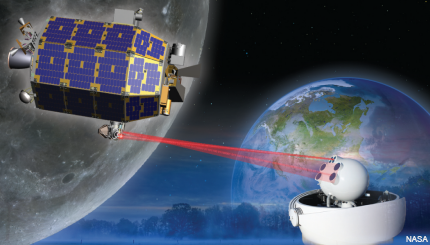DISA mulls laser system for satellite communications
All-optical systems potentially offer increased data transfer rates and better security while avoiding the crowded electromagnetic spectrum.

NASA first demonstrated laser communications in space in October 2013. (Artist’s illustration)
To deal with growing communications problems such as an increasingly crowded electromagnetic spectrum and a growing risk of interception, the Defense Information Systems Agency will begin considering the use of laser-based satellite communications technology.
Laser Light Communications announced a Cooperative Research and Development Agreement with the agency on June 10 in regards to the company’s Global Hybrid Satellite-Terrestrial All Optical Network Technology.
The research effort will focus primarily on the potential use of an all-optical, laser-based, medium Earth orbit (MEO) communication satellite solution that could be seamlessly integrated into the global terrestrial communications network, according to the release. Laser communications would bypass the use of the traditional radio frequency spectrum by using pulses of light to communicate large amounts of information – the effect would be the same as using a fiber optic cable, but without an actual cable.
NASA was the first to demonstrate the feasibility of laser communication in 2013. The Lunar Laser Communications Demonstration was able to transmit data from the moon to the Earth at a rate of 622 megabits/sec, which was six times faster than previous state-of-the-art radio systems.
An all-optical satellite communications system is potentially capable of significantly increasing data transfer rates. Also, because the system doesn’t use the radio frequency spectrum, it won’t have to deal with spectrum allocation or mutual interference due to satellite spacing. The Defense Department currently is faced with increasing demand on the electromagnetic spectrum for military use while freeing up bandwidth for commercial use.
The system is also more secure because optical signals cannot be intercepted, reports National Defense Magazine. Government agencies that require secure communications, such as the Defense and State departments, could send information directly, rather than encrypting the information and sending it back through a fiber optic cable that could be tapped.
Laser Light Communications, launched in 2012, is intending to deploy the world’s first optical wave satellite communications.
The company plans on creating a 12-satellite constellation in MEO with an operating system capacity of 4.8 terabytes/sec and satellite-to-satellite optical crosslinks and satellite-to-ground optical up/down links of 200 gigabytes/sec. The company envisions integrating the Optical Satellite System with existing terrestrial and undersea fiber optic levels. Laser Light currently expects to deploy the system in the first quarter of 2017.
The new agreement will allow DISA to evaluate the feasibility of the underlying technology and the future potential of the all-optical system in terms of how it could help its mission of providing information systems support to DOD.